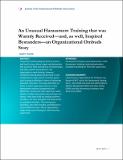05. Bystanders and the Bystanders of Bystanders
This page includes articles from 1998-2021 in reverse chronological order. Some major points:
In these articles, the term “bystander” is used for people who observe or come to know about the behavior of others (whether unacceptable or exemplary behavior), but who are not knowingly engaged in planning or executing that behavior.
The public image of bystanders is that they are all “do-nothings” who watch something transpire without taking action. However, Rowe’s research shows that the reality is quite different. Bystanders in organizations and communities—people who either witness unacceptable behavior or see someone struggling to get traction for a good idea—often do intervene, in one or more of dozens of effective ways. Bystanders of bystanders also frequently act in helpful ways in organizations by supporting bystanders. Powerful bystanders are frequently the only effective constraint on the behavior of the most powerful offenders.
However, bystanders often have multiple, conflicting, idiosyncratic, and changeable motivations and are very strongly influenced by context. Responsible bystanders need receptivity from their organizations and communities if they are to seek help. They may face serious barriers and dilemmas. They often hesitate before acting on their own or reporting unacceptable behavior—or even offering good ideas. They may need confidential and customized support to act or come forward about illegal behavior.
A conflict management system can enhance receptivity. At the front end, providing confidential informal resources helps make a complaint system appear more receptive. For example, an organizational ombuds can provide multiple options for getting information about conduct violations to managers and other authorities while protecting the confidentiality of bystanders and reducing the risks they face in coming forward.
When it comes to formal interventions, it is essential that bystanders can trust the people they turn to for help. This is especially true if there is a need for investigations; one cannot overestimate the importance to fearful bystanders of their being able to trust investigation processes. (Providing fair, prompt, independent, and competent formal investigations is a challenge which calls for significant resources.)
In diversity and safety programs, bystander training is becoming more common, to help prevent and respond to harassment and unsafe behavior. Bystander training can expand beyond introductory sessions that deal with an immediate, dangerous situation to include mundane, day-to-day bystander actions that can help to change a culture over time. Training managers to become receptive to concerns brought to them and to become active bystanders themselves may increase the effectiveness of bystander training programs.
The nation needs a bystander research agenda to address questions such as:
- Are bystanders more effective in systems that focus resources on respectful, kind, and affirming behavior?
- What do we need to know about bystanders causing harm, whether inadvertently or intentionally?
- How do bystanders help when they perceive exemplary behavior that is overlooked, and does this help in changing a culture?
- Are people more productive and less prone to burnout in organizations and communities where bystanders are encouraged to act effectively if they witness abuse?
Collections in this community
Recent Submissions
-
Fostering Constructive Action by Peers and Bystanders in Organizations and Communities
(Negotiation Journal, 2018-04) -
An Unusual Harassment Training That Was Warmly Received—and, as well, Inspired Bystanders—an Organizational Ombuds Story
(Journal of the International Ombuds Association, 2025-04)Harassment and bullying are hard to endure and hard to stop. Many targets and bystanders fear to ask for help, fearing loss of relationships and other painful consequences. All organizations need training. However, sensitivity ... -
Helping Hesitant Bystanders Identify Their Options: A Checklist with Examples and Ideas to Consider
(Journal of the International Ombudsman Association, 2023-07-14)Organizational bystanders sometimes act heroically in emergencies. Less well known are the bystanders who act very effectively, in quiet ways, in reaction to (potentially) unacceptable behavior. In addition, many bystanders ...


